Harvesting lavender each year is one of the greatest joys here on the hill. Timing when to harvest, prune, cut back, and dry is a skill to hone.
This post may contain affiliate links at no additional cost to you. By making your purchases through the links on this website, IMSL may make a small percentage at no direct cost to you. IMSL only promotes products we use & truly believe in. Please refer to my Privacy & Disclosures for further information. IMSL thanks you for your support!
Ahhhhh, lavender. When it’s in full bloom, there may be no other scent that as seductive. As much as I love lavender for the scent alone, this heady perennial herb offers so much more. But more about the benefits of lavender in a minute.
LAVENDER’S AROMATHERAPY BENEFITS
Can we just talk about the scent for a sec? Long known for it’s aromatherapy benefits, lavender is a go to for anyone looking to de-stress & relax.
Lavender’s many benefits extend far beyond its aroma. When looking at all its benefits in my tutorial “How To Make a Lavender & Flax Eye Pillow” I found a few of the following.
The benefits of lavender essential oil are many. Not only is lavender considered to have antiseptic & anti-inflammatory properties, but it’s aromatherapy benefits include treating insomnia, creating a sense of relaxation, treating restlessness, depression, and anxiety.
IMSL
In addition to it’s aromatherapeutic benefits, lavender is now being studied in-depth for more than just its calming abilities. In addition to “inducing relaxation to treating parasitic infections, burns, insect bites, and spasm”, there “is growing evidence suggesting that lavender oil may be an effective medicament in treatment of several neurological disorders”.
I believe we are only beginning to understand lavenders powerful potential. Until that time, you can be sure that I will enjoy it for its beauty in my garden, my oils (keep on the lookout for how to make your own lavender oil!), my crafts, and my culinary efforts.
LAVENDER VARIETIES & BLOOMING SEASONS
Lavender connoisseurs can be picky about which variety of lavender they wish to cultivate. Me? I believe it’s all about what you want to utilize the lavender for & the climate you are working with.
There are many choices when it comes to lavender, belonging to the genus Lavendula. Presently there are approximately 45 different species of lavender with over 450 varieties. However, we can notch that down to four main commonly known ones here.
It’s important that you know your gardening zone when choosing your lavender varieties. If you don’t already know your zone, you can use this handy dandy tool which uses only your zip code.
- ENGLISH LAVENDER – Botanical name, L angustifolia, does well in cool climates, making a great choice for USDA Hardiness Zones 5-8. Although all lavender has its roots from the Mediterranean, English lavender has been dubbed such due to its hardiness and ability to grow under these conditions. English lavender has also been known to be called “True Lavender” and “Common Lavender” and is a wonderful addition to any culinary effort due to its low camphor content. English lavender blooms typically from June to August, grows in a more compact growth pattern (although it can reach between 2-3 ft in height), “Hidcote” being one of the most common variety.
- FRENCH LAVENDER – Botanical name, L dantata, also called “fringed lavender” also does well in cooler climates. French lavender varieties will grow in gardening zones 8-11 and blooms early summer to fall. French lavender will grow compactly to a height of 36 inches or higher and tend to be less aromatic than the English varieties.
- SPANISH LAVENDER – Botanical name, L stoechas, also grows well in zones 8-11 and blooms during the mid-summer to late-summer months. Spanish lavender grows to a height of 18-24 inches in a unique way. It’s blooms growing in pineapple shaped flowers looking very much like “bunny ears”. It should be noted that the blooms don’t hold much scent, but the leaves do.
- LAVANDIN – Botanical name, L x intermedia, grows in zones 5-11 and blooms from mid-summer to late-summer. It grows to a height of 2 to 2.5 feet tall and has strongly scented flowers and foliage, thus making this variety a good choice for sachets and other crafts. Due to its high camphor content, lavandin does not make for good eating.
GROWING LAVENDER
Lavender planted in my herb bed brings me such joy. A simple walk by or brush up while working around these beds always reminds me of giving birth to my daughter (it was my preferred oil to use while pregnant) and brings a big smile to my heart.

As I’m not a fussy gardener at all and have no patience with “needy” plants, lavender and I are a well suited couple 😁
GROWING LAVENDER REQUIREMENTS
Growing perennial lavender is fairly easy when you are working with the right climate for the variety you’ve chosen, sunlight, and the right soil conditions. You can grow lavender from seed, however, it is a fairly slow grower and quite frankly, I don’t have the patience. By far, the best way to produce multiple plants is from cuttings. Take a look at the tutorial “Propagating Herbs From Cuttings” for a complete guide to creating those extra plants.
SUNLIGHT – My lavender thrives in full, hot sun, in zone 5. Should you live in hotter climates, you may want to consider an area of the garden that receives some shade during the hot afternoons.
SOIL – Lavender prefers well-drained, low to moderately low fertile soils with a neutral to slightly low alkaline level, ideally a pH level of around 7.0. If you are unsure about your soils alkalinity levels, you may want to have a soil test performed at your local extension office.
WATER – Water lavender only when the soil is dry. It’s recommended to water deeply, but not often.
When planting lavender time matters. What time of year that is. For those in colder areas than garden zone 6, plan on planting during the spring or early summer months. For those in zones 7-10 (warmer than zone 6), plan on planting during the early fall months.
Once you have your space determined & your soil tested and ready, follow the instructions on the tag of the plant you’ve purchased for proper spacing requirements. Spacing will largely be dependent on the variety you are planting, but in general, plan on placing the plants roughly 1-3 feet apart from one another.
HOW TO CARE FOR LAVENDER PLANTS
In more temperate climates, lavender can grow quite large and bushy. Here in New England, it remains rather on the smaller side of things. My plants still reach a height of about 2 feet however. If you reside in a fairly humid area, you will want to be sure your plants receive good air-flow by providing enough space for them to grow well. This will reduce chances of fungus or powdery mildew from developing.
Although lavender can grow quite large in some areas, they require no staking for support. Lavender is really a low maintenance herb. It doesn’t appreciate being fertilized or fed, it’s drought tolerant and actually loves to be on the dry side. In fact, over-watering is the demise of many lavender plants. It doesn’t need to be mulched to conserve moisture, but if you do as I do and mulch my whole herb bed, make sure you leave the crown free from mulch by several inches to prevent rot.
For those in northern, cold climates, your lavender will benefit from mulching late fall to protect from extreme temperatures. After the first frost, cover well with bark mulch, hay, or wood chips and plan on removing this mulch early spring.
DEADHEADING LAVENDER FLOWERS
Should you plan on deadheading your lavender plants?
Yup! Especially if you are not planning to harvest the blooms. By cutting off the blooms that have faded and passed, you are encouraging new blooms to emerge.
To deadhead, plan on cutting the blooms when the bottom third of the blossom itself are open. Realize this will be an ongoing process as they will not all bloom at the same time.
PRUNING LAVENDER TIPS
What’s the difference between harvesting and pruning (cutting back) when it come to your lavender? Harvesting is where you trim only the parts of the plant that you will be using. Pruning is a more aggressive approach to remove overgrown or dead branches & stems to promote further growth & slow down woody development on the plant.
Again, lavender can grow quite large in more temperate climates. As lavender can become very woody, it will benefit from a good pruning once or twice yearly.
- It’s recommended to prune after the first flowering (if you are not harvesting) and again in late summer after the last blooms have passed. This is also known as “cutting back”
- Consider the first harvest as your first prune
- Plan on cutting about 2/3 of the plants height, to just above the bottom 2 sets of leaves on each stem
- Avoid going into the woody stem as it can damage your plant by leaving at least a couple of leaf nodes above this area
- For English varieties: prune by 1/2 to 2/3 of new growth each fall
- For Spanish, French, & Lavandin varieties: approach a bit more gently than you would the hardy English variety. Plan on harvesting, & deadheading throughout the early growing season & giving a light pruning, taking no more than 1/3 of the plant
Pruning may be hard to do for many. After all, you’ve grown a beautiful plant that has just put on a great show of blooms, and now you want me to do what? Cut it back?
I always have a hard time taking those shears and getting aggressive with my plants when they are looking so beautiful. But they appreciate it and actually flourish from it.
When it comes to lavender, it’s resilient and those mature plants will thank you for a good pruning.
HOW TO HARVEST LAVENDER
By harvesting at the right times during the initial blooming period, typically during the early to mid-summer months (for me that means end of June to early July) will help to promote future blooms and growth.
It not only helps with creating a healthy lavender plant, BUT, I can also have amazingly beautiful, fragrant flower buds to utilize in so many ways. But I get ahead of myself.
WHEN TO HARVEST LAVENDER
The “when” to harvest lavender flowers largely depends on your location and climate. For colder climates such as mine our growing season is much shorter than that of more temperate climates.
For that reason, colder climate lavender will need to be harvested after the first blooms, as early in the spring or early summer as possible. This will allow the plant to hopefully have time to produce a second bloom time. More temperate climates will have longer bloom times, some year round! Those lucky ducks can continue to harvest small amounts throughout the year.
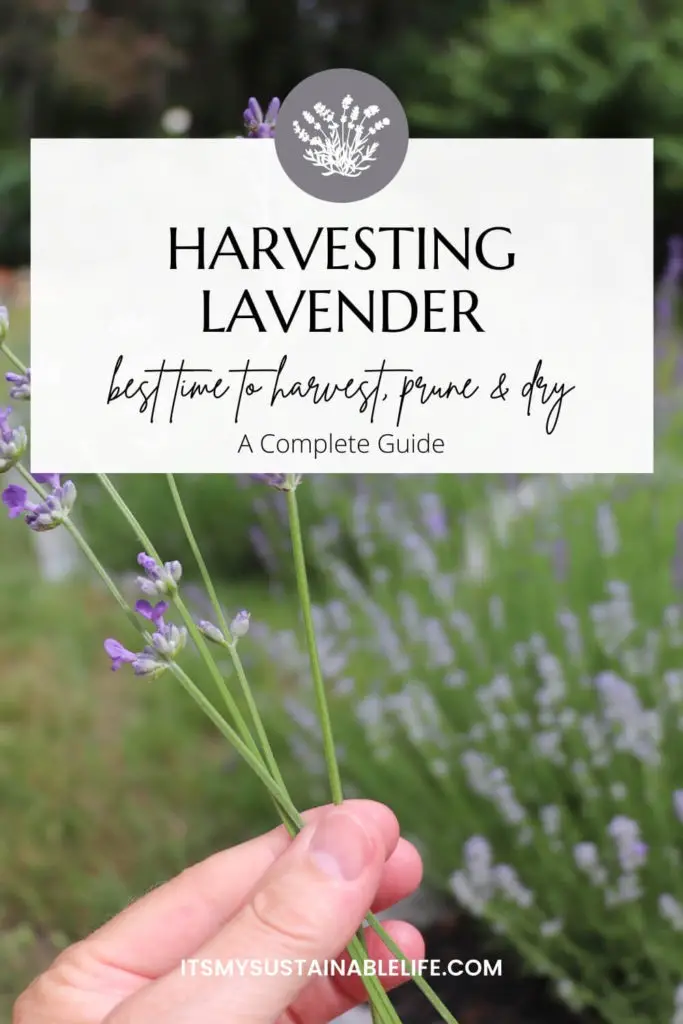
No matter your climate, lavender should be harvested as early in the morning once the dew has dried as possible. Heat during peak hours of the day can not only dry the moisture from the blooms, but can also draw out too much of the essential oil & terpenes. Harnessing all that goodness is what we are striving for here! This holds especially true when your intent is to utilize lavender for its medicinal benefits.
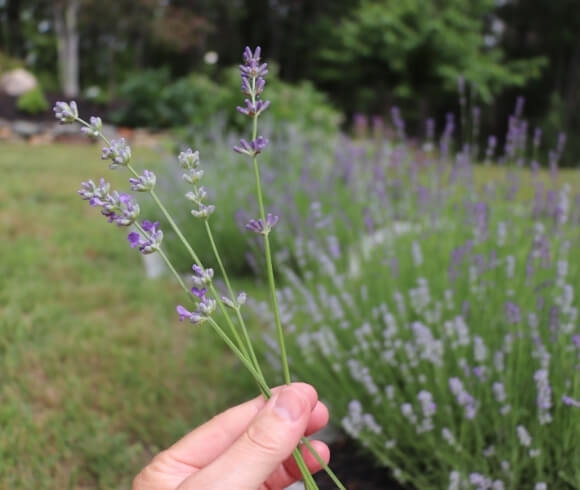
The above image shows the different growth rates of sprigs of lavender. Lavender buds grow and emerge on the stem at different rates. You can see from top to bottom of the stem new buds forming along the spike. As you go down this area you can see on the left stem a darker purple flower or “corolla” that has emerged from the bud.
These stems were harvested from the same plant. It really shows the different growth rates all from the same plant.
There are a few theory’s concerning the best uses for the different stages of flower development.
FOR ITS SCENT. When it comes to utilizing the harvested lavender for its scent, some herbalists will recommend harvesting the lavender at its early stages, when the buds remain tightly closed and have not fully opened as the lavender’s scent & essential oils are at an all time high.
FOR BOUQUETS & COOKING. The best time for harvesting when it comes to using your lavender for making bouquets or in your culinary adventures, is when only a few of the buds have fully bloomed. This creates more diverse, colorful arrangements when dried.
All parts of the lavender plant, bud, stem, and leaf, can be eaten and used as you would rosemary. Lavender flowers & leaves can be used fresh, while the stems and buds can be used dried.
As a general rule of thumb, when harvesting to dry for use in potpourri, crafts, bouquets or culinary uses, plan on harvesting when 25% to 50% of the buds are in full bloom. For essential oil distillation, you will want to wait until 50% to 100% of the buds are in bloom.
BEST TOOLS FOR HARVESTING & PRUNING LAVENDER
When harvesting individual stems of lavender, use a sharp pair of micro-tipped pruning snips, bonsai or garden scissors. All will work well.
When pruning lavender, although the above will work as well, bypass pruners or hand sickle will work even better.
WHERE ON THE STEM TO HARVEST LAVENDER FLOWERS
When it comes to harvesting your lavender you have two methods of choice. Harvesting individual stems or harvesting by the handful.
To harvest individual stems, be patient. It’s best to harvest each one individually. And that can take a while. On a positive note? It’s an enjoyable task. How can it not be when you are breathing in all that aroma?
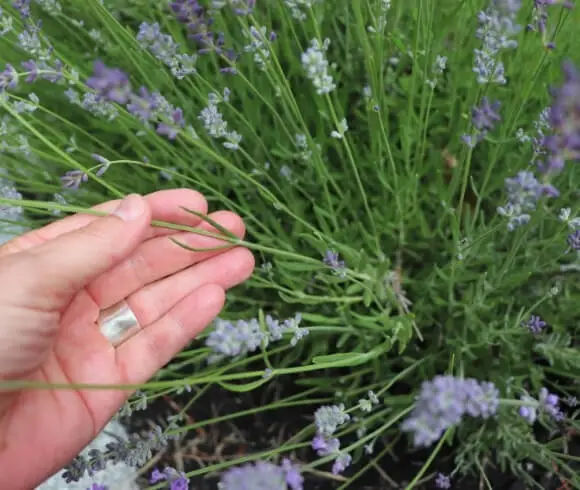
Once you’ve picked your stem to harvest, I take my cutting tool and gently follow down the stem, cutting at any leaf node, new bud, or branching junction below the first two leaves that are found below the top of the stem flower. As you progress down the stem, leaves will be thicker and more prominent. Be sure to make your cut ABOVE any of these junctions you choose. It largely depends on how long you want your stems to be.
It’s important to note that you should leave at least 2 sets of leaves on the green part of the stem. I like to leave a bit more to be on the safe side, 2-4 sets of leaves. Should you cut into the woody part, it can be a bit of a crap shoot if you will have any new regrowth or not.
When harvesting by the handful, simply grab a bunch of stems above the thicker leaf development and cut using a harvesting knife or garden shears. Be careful to not damage any of the blooms. Plan on mature plants providing 8-10 bunches and younger plants less.
I find it helpful when harvesting larger bundles (keep to a size that can be grasped between your pointer finger and thumb for good ventilation) to actually bundle them. I have ready at hand a ball of twine or elastics to tie up those bundles to hang for drying. I pretty much the same technique for drying basil as I do my lavender. Click the link for a full tutorial.
HOW TO USE YOUR LAVENDER HARVEST
Now that you’ve harvested baskets of lavender, what’s next? Here are just a few ideas. For smaller sprays, I like to snip the stems evenly and place in a favorite vase (with water for bouquets, sans water for drying), for beautiful displays.
Make a fresh lavender wreath, especially good to do after a good pruning. You can find a simple tutorial on how to make your own HERE.
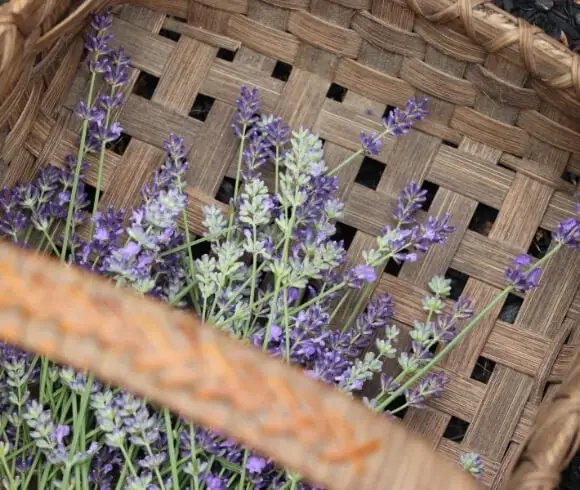
HOW TO DRY LAVENDER FLOWERS
Since the majority of applications for lavender require the buds and flowers to be dried, let’s take a more in-depth peek at how I do just that.
HANGING LAVENDER HARVEST TO DRY
If you haven’t already taken a look at my basil tutorial, it gives a more in-depth tutorial on drying herbs. The best way to dry is to hang them in my opinion. Obviously those who live in tropical or humid areas, you may have an issue with this method and will want to utilize other suggestions found below.
That being said, however, I always dry a few small bouquets in my favorite vase and leave without water. I’ve never had any issue with the stems rotting, flopping over, or not drying fully. Be sure to not overstuff your vase to allow for a good amount of airflow to prevent rotting or molding.
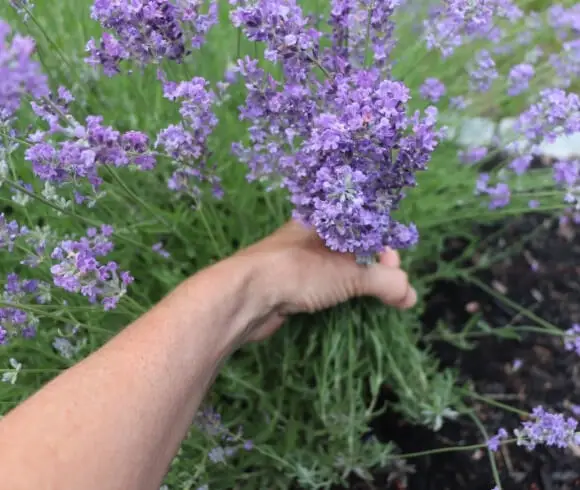
To hang lavender to dry, follow these simple suggestions for best results.
- Harvest your lavender in small handfuls (pointer finger touching thumb circle size), and tie with twine, raffia, or rubber band.
- Hang your lavender bundles upside down in a dark, well-ventilated area. In those high humidity areas, consider running a fan on low to circulate the air
- Humidity & climate conditions in your area will determine the length of time it takes for your lavender to fully dry. Time to fully dry your lavender can take just a few weeks to a full month depending on these variables
When using a tie to dry your lavender, it should be noted that you may have to tighten the bunches as it will loosen as the lavender naturally shrinks during the drying process.
USING A DEHYDRATOR TO DRY LAVENDER
If you are dealing with high humidity or live in a tropical area, you may want to consider utilizing a food dehydrator to dry your lavender. Carefully.
When using a food dehydrator, be sure to avoid overheating as over drying your lavender may result in loss of the therapeutic benefits of lavenders natural essential oils. For this reason, I highly recommend only using a dehydrator which has temperature settings available, such as the Excalibur, use the “living food” low temperature setting, 95F to 105F only.
To dry lavender using a food dehydrator follow a few simple guidelines.
- Gather your lavender harvest, trimming off excess stem material. You will want only the buds of lavender here with as little stem as possible
- Place buds on the trays provided with your dehydrator. If needed, you can utilize dehydrator tray liners or parchment paper to help keep them from falling through larger openings on the tray
- Dry on the low temp setting for 24-48 hours, until fully dry. The bud, when broken apart, should feel dry through and through, break apart easily, and crumble if squeezed
- After the buds are fully dry, store in an air-tight container
STORING DRIED LAVENDER
Once you’ve dried your lavender harvest, properly storing it will preserve it beautifully.
You have a couple of options for storing dried lavender, once again, largely dependent on what you intend to use it for. You can leave any stem intact, especially good when you want to use in bouquets, or you can snip the stems and remove the buds and flowers from the remaining stem as much as possible, great if you are using in creating medicinals, salves, or oils.
Place your dried lavender in either zip-lock bags (I re-use mine often) or any airtight container of your choice. Store the container away from light, excessive heat or humidity.
Proper storage will preserve lavenders fragrance (up to a year when properly dried & stored), color of the buds and flowers, and will avoid any rotting or molding issues.
UNIQUE USES FOR THE LAVENDER HARVEST
What to do with all the dried lavender you’ve gathered? Oh, let me count the ways.
Here are a few unique idea’s for what to do with your dried lavender 😊
LAVENDER HARVEST FOR RELAXATION
Got stress? I think we all do at some level.
Lavender’s aromatherapeutic benefits have been proven to aid in all things stress related, insomnia, depression, stress & anxiety issues.
A few unique uses for dried lavender for relaxation are:
- BATH SALTS – Add your dried lavender with a bit of dried rosemary along with some epsom salts, mix well and add to your bath
- LAVENDER SPRAY – Create a relaxing bedtime linen spray using infused witch-hazel (recipe below), essential oil, and distilled water
- LAVENDER EYE PILLOW – Easy to make, and efficacious to use, eye pillows, aka dream pillow or yoga pillows are a must for those seeking relaxation on any level
- LAVENDER BATH BOMBS – This is one thing I’ve yet to try making (it is on the to do list for sure!). Make these beautiful lavender bath bombs by following Crystal’s great tutorial over at A Pumpkin And A Princess
LAVENDER HARVEST FOR PERSONAL CARE PRODUCTS
If you’re familiar with all things IMSL, you know how I love to create my own personal care products. Why? Because they work, reduce our overall exposure to unwanted chemicals, and are just fun to make!
Here are a few idea’s of what you can make with your dried lavenders:
- LAVENDER INFUSED WITCH HAZEL – Infusing witch hazel with lavender makes for a wonderful base for anti-septic sprays. To make simply place your dried lavender in a jar, cover by 2 inches with witch hazel extract, cover, shake to incorporate, place in a cool dark place and infuse for a minimum of 2 weeks. Strain and store
- LAVENDER ANTISEPTIC SPRAY – Take 1 C distilled water, 2 Tbl lavender infused witch hazel and add 5-12 drops of lavender essential oil. Mix well and place in a spritzer bottle for use
- LAVENDER INFUSED OIL – This wonderful infused oil can be used in so many applications. Massage into scalp to relieve dry, itchy scalps, massage legs to help relieve restless legs, use to help relieve bug bites, and as an ingredient for salves, balms, moisturizers, creams, soaps, and so much more! A full tutorial on how to make your own coming soon!
- ANTI-ITCH BUG ROLLERBALL – Add lavender infused oil along with lavender essential oil to a rollerball and use as a lovely perfume, & dab those nasty bug bites
- LAVENDER SALVE, BALM, MOISTURIZER & MORE – Use your wonderful infused lavender oil to create unique salves, balms, moisturizers, lotion bars, creams, lotions and so much more! Your only limitation is your imagination here
- LAVENDER & HONEY SCRUB – Take about 1/4 C sugar, 1 Tbl lavender infused oil, 1 tsp honey, and add lavender essential oil to suit. Use to exfoliate dry skin, help relieve eczema breakouts, soften elbows, knees, and feet
- LAVENDER TINCTURE – A full tutorial on how to make your own tinctures, 2 different methods, can be found HERE. Lavender tincture can be used for treatment of headaches & migraines by simply rubbing on temples, and diluted with distilled water (30 drops tincture to 1/2 cup water) for use in treatment of skin sores and infections. Plan on using 1 part dried lavender to 5 parts alcohol or 1:2 ratio of fresh flower to alcohol when making
LAVENDER HARVEST IN EDIBLE CULINARY USES
So many have such great idea’s for how to make your kitchen creations! Here are a few of my favorites:
- LAVENDER SIMPLE SYRUP – Make a simple syrup for use in your favorite cocktails, beverages, and even kombucha! To make a lavender simple syrup take 1 C water, 3 Tbl fresh flowers (or use dried instead) and 2 C sugar combine in a saucepan. Bring the mixture to a boil, reduce to simmer for 15 minutes, remove from the heat and allow to steep for at least an hour or more, strain, bottle, and store in the refrigerator for use
- LAVENDER INFUSED SUGAR – Interested in an optional lavender sweetener? This makes for a wonderful gift to all your tea loving friends too! My friend Kathie over at Homespun Seasonal Living has a great tutorial on how to make your own!
- LAVENDER LEMONADE – To make your own lavender lemonade use 1 C raw honey (local is best), 5 C water, 1 Tbl dried lavender or 1/4 C fresh blooms crushed placed in a tea strainer, 1 C freshly squeezed lemon juice. Bring half the water (2.5C) to a boil, remove from heat and add honey & lavender allowing it to steep for at least 20 minutes and up to several hours. Strain , add remaining water, lemon juice and refrigerate for use. Optionally, use your lavender simple syrup or lavender infused sugar along with honey as a sweetener!
- LAVENDER BAKED GOODS – Add dried lavender buds to baked products for a unique flavor addition. Combine with rosemary to create some delicious crackers, or with honey and make a homemade bread, lavender & lemon cake, or how about baking some goat cheese & lavender spread? So many options
LAVENDER HARVEST FOR USE IN CRAFTS
We’ve already mentioned making your own eye pillows or wreaths, but here are a few additional idea’s for all you crafty readers.
- LAVENDER DRYER BAGS, SACHETS, & MORE – To make little bags filled with amazing scent is easy to do. For ease you can use small muslin drawstring bags, cheesecloth, or even repurposed vintage hanky’s, fill, and tie very well for use
- CANDLES – What makes a candle even better? One that’s homemade with love. Check out this simple tutorial from Amanda over at Crafts By Amanda to make your own to enjoy or give as gifts
- LAVENDER CONFETTI – Are you a conscientious bride-to-be and looking to have your guests toss a lovely confetti? Make your own using dried lavender buds
SOURCING DRIED LAVENDER
Don’t grow your own lavender but are interested in making some of your own products, foods, or crafts? My number one source for all things herbal is Mountain Rose Herbs.
Visit their beautiful site to order yours and get making!
I hope this guide has shown you that harvesting lavender is not hard to do. In fact, it’s all in the timing. Join in the conversation below with any questions or suggestions, and help spread the lavender love by sharing 😊
Do you harvest, prune, & dry your own lavender?
Love, Light, & Laughter ~


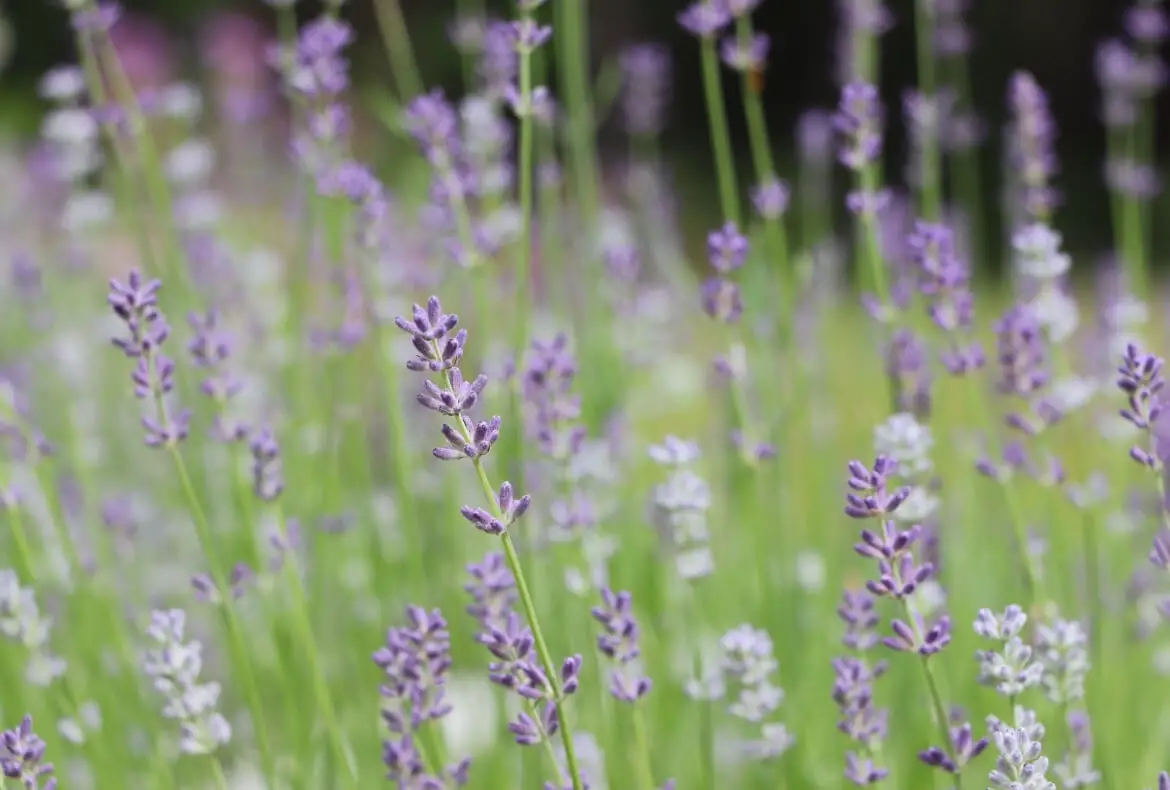


20 comments
Great post Suzan, I need to do this next week. Lavender is so lovely and has so many uses. I am happy to feature your post about harvesting lavender at Love Your Creativity.
Thank you, Linda! I’m pleased you found this article useful.
Great post. I’m wanting to try growing lavender and this post gave me everything I needed to know. I’ll definitely be back as I progress. Congratulations on your feature on Saturday Sparks.
This is fantastic! I have a lavender plant but had only used it in the garden – although I love dried lavender, somehow I had never though to dry my own! I’m looking forward to you post on how to make essential oils!
Lavender is absolutely hands down my favorite. I have quite a few plants in my garden but was always stumped on how to care for it and when to harvest it. This has helped me so much to understand there is some pruning needed for sure and how and when to harvest it. So comprehensive, I’ve bookmarked this. Thank you for sharing this.
Thank you, Dawn, for your kind words! I’m so happy you found this so useful.
Such a useful post! I have really struggled to grow lavender, but am going to give it another go with the tips you have outlined 🙂
Hope they help, Kimberly!
This is a very thorough article on lavender, my mom is getting ready to harvest hers, and I will be sending this link her way, as a great guide to review! I struggle to get it to survive as I am actually in zone 4, but I keep trying to find that warm microclimate on my property, that it might thrive, I am trying it near the foundation of the house this year, fingers crossed it comes back next year, but it might just be too cold!
Hopefully the tips on mulching will help you out this winter, Carey! Good Luck!!
I absolutely love lavender and grow it in my garden too!
A lot of great information! We recently purchased a new home and there is lavender in the yard. I don’t know what variety it is? It looked great in May but is not looking so great now in July. You gave me some great information on how to care for it and how to dry it. Thanks!
You’re welcome!
Fabulous post. I grow lavender too, and this was so informative. I really didn’t know how to harvest it. Thank you so much.
So glad you found it useful! Happy Harvesting!!
This post was so good and very comprehensive. Thank you so much for sharing all of your knowledge. I really love lavender, and this helps with knowing how to care for mine properly.
Thank you for all this good information! I’m (not so) patiently watching my lavender grow from seeds…can’t wait to get to the point of smelling them as I walk by!
Oh, you are a brave one 😂. Patience is key, it can take a loooonnnnnnggggggg time to grow from seed. Thanks for stopping by & good luck!
Wow! I had no idea there was so much involved – yet you broke it down in a way that was enjoyable to read.
I love everything about lavender, thank you so much for the information about harvesting and drying. Will try it out 🙂